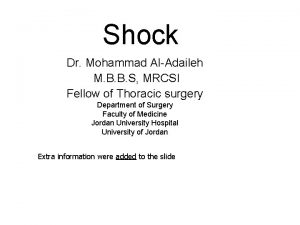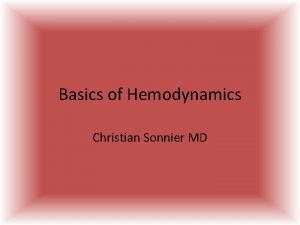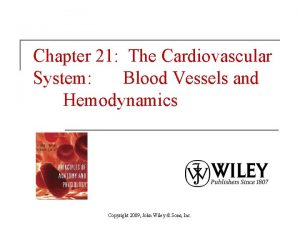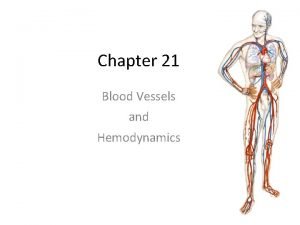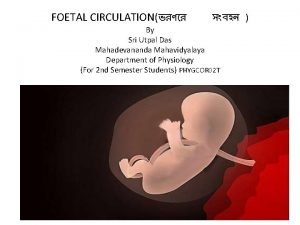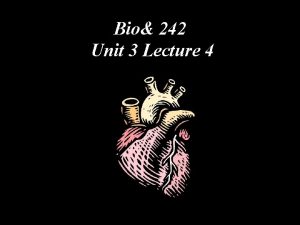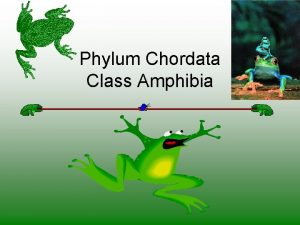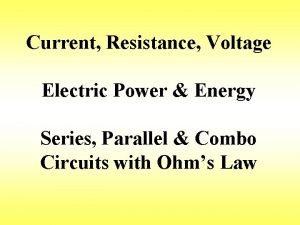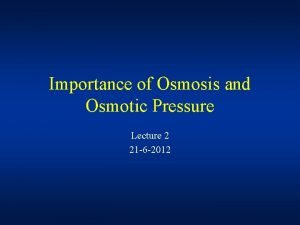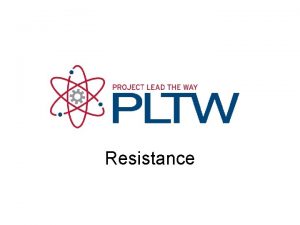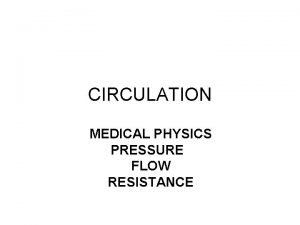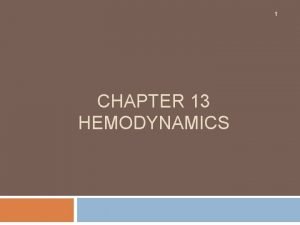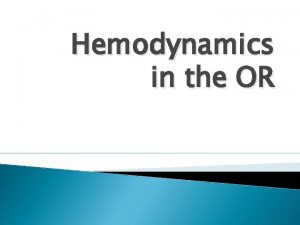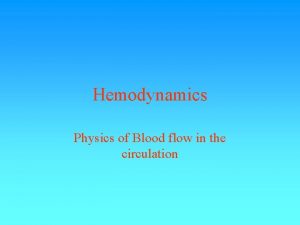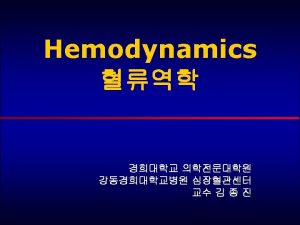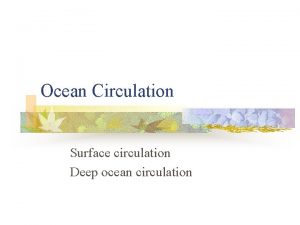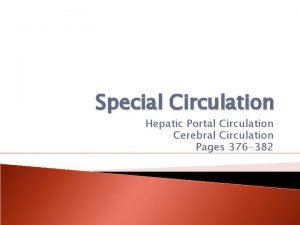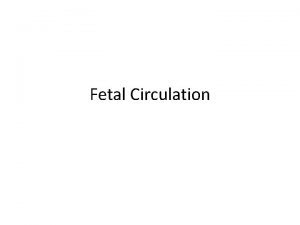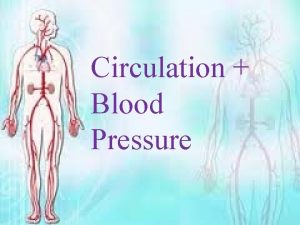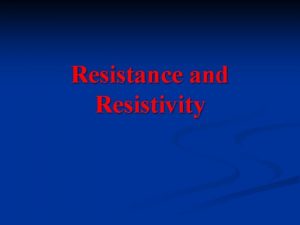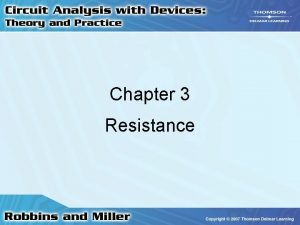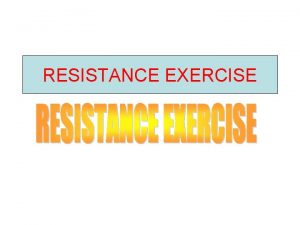The Circulation Hemodynamics I Pressure Flow and Resistance



















- Slides: 19

The Circulation: Hemodynamics I Pressure, Flow, and Resistance Dr. Waleed R. Ezzat

Lecture Objectives: n n n Study relationship between pressure, flow and resistance. Discuss laminar and turbulent blood flow. Understand methods for measurement of blood flow. Define blood pressure and its standard unit. Discuss resistance to blood flow, peripheral and pulmonary resistance and the effect of hematocrit on vascular resistance.

Organization of the systemic (peripheral) circulation - - The CVS is a closed circulation Circuits are arranged in parallel (this allows the adjustment of blood flow to an individual organ to meet its own needs without creating major disturbances in the blood supply to other organs) Individual segments (parts) of each circuit are arranged in series Two circuits in series are called portal system (there are 3 portal systems in the human body)


Functions of the vascular components 1. 2. Arteries – Transport blood under high pressure to the tissues in pulsatile fashion. Also called resistant vessels. Arteries hold 13% of blood volume only. Arterioles – Act as control conduits. (1) They can regulate the blood flow and pressure by regulating their own diameter. They have strong muscular wall (arranged in circular layers) and they are richly supplied with sympathetic nerve terminals. (2) Arterioles are the site of major vascular resistance and the site of the major loss in hydrostatic blood pressure. (3) Across arterioles the pulsatile blood flow is converted to steady (laminar) blood flow before it reaches the capillaries.


Functions of the vascular components (Cont. ) 3. 4. 5. Capillaries – Allows the exchange of fluid, nutrients, electrolytes, hormones, and other substances between blood and the interstitial fluid mainly by simple diffusion. Capillaries have thin wall with pores that make it permeable to water and other small molecular substances. Venules – Conduits that collect blood from the capillaries. Veins – Also called capacitance vessels. (1) Acts as conduits for transport of blood from tissues back to the heart. (2) Serve as a major reservoir of blood (veins hold 64% of blood volume). Because of their high capacitance (or compliance) their muscular wall can contract or relax to control its reservoir function depending on the need of the circulation.


Velocity versus blood flow Velocity is measured by meter/min or cm/sec - Blood flow is measured by ml/min or L/min. Over all blood flow = 5000 ml/min = Cardiac output - Velocity X Cross-sectional area = Blood flow - The velocity of blood is the highest in the aorta (33 cm/min) and lowest in the capillaries (0. 3 mm/sec). -


Relationship between pressure, flow, and resistance Flow to each vascular bed is variable according to tissue need - Flow is determined by pressure gradient (∆P) and the impediment (i. e. vascular resistance) to blood flow Q (flow) = ∆P/R (Ohm’s law) - ∆P is maintained relatively constant so that the flow in each circuit can be controlled by changing the resistance of that circuit without affecting the flow in other circuits. -



Methods for measuring blood flow 1. Electromagnetic flowmeter 2. Ultrasonic Doppler flowmeter

Laminar flow versus turbulent flow Blood flow is normally laminar (stream line), with platelets and blood cells remaining in the center or axis of the bloodstream Laminar flow will be converted into turbulent flow (develop vortices or whirlpool) if velocity increased to a certain limit. This can happen after narrow opening such as behind stenosed valves. Turbulence is usually accompanied by vibrations of the fluid and surrounding structures. Some of these vibrations in the cardiovascular system are in the audible frequency range and may be detected as murmurs or bruits. Clot formation is liable to form in turbulent flow.

Blood pressure It is the force exerted by the blood against any unit area of the vessel wall. It is measured in mm. Hg. In veins the pressure is measured occasionally in centimeters of water (cm H 2 O). 1 mm. Hg = 1. 36 cm H 2 O

Resistance to blood flow - - - Resistance unit must be calculated (by using Ohm’s law), and cannot be measured 1 peripheral resistance unit (PRU) = the resistance that causes 1 ml/sec change in blood flow for 1 mm. Hg pressure gradient The total peripheral resistance (TPR) is about 1 PRU Maximal vasoconstriction → 4 PRU Maximal vasodilation → 0. 2 PRU The total pulmonary vascular resistance is about 0. 14 PRU (i. e. 1/7 that in the systemic circulation) Conductance = 1/Resistance = a measure of blood flow through a vessel for a given pressure difference In physiology the prime factor that affect the resistance is the diameter of the vessel (Poiseuille’s law) Resistance (R) α 1 / r 4 or, conductance α diameter 4

Effect of blood hematocrit and blood viscosity on resistance The greater the hematocrit, the greater the viscosity, the less is the flow in a vessel (Poiseuille’s law) - The hematocrit is the percentage of the blood that is cells (mainly due to large numbers of red cells) - In polycythemia hematocrit can rise to 60 or 70% and blood viscosity can rise by three folds. This creates great after load on the heart and eventually ends in heart failure -

Test: Vascular resistance? A. Increases by 50 per cent when the vascular radius is halved. B. Is related to the thickness of the wall of the vessel. C. Is affected by blood velocity. D. Is affected by blood hematocrit. E. Is greater in the capillary bed than in the arteriolar bed.
 Single circulation and double circulation
Single circulation and double circulation Single circulation and double circulation
Single circulation and double circulation Alveoli definition
Alveoli definition Shock prof
Shock prof Three types of shock
Three types of shock Hemodynamics made incredibly visual
Hemodynamics made incredibly visual Chapter 21 hemodynamics
Chapter 21 hemodynamics Arterioles function
Arterioles function Hemodynamics
Hemodynamics Filtration introduction
Filtration introduction What is a force that opposes motion through direct contact
What is a force that opposes motion through direct contact Fetal circulation
Fetal circulation Fetal circulation flow chart
Fetal circulation flow chart Flow of coronary circulation
Flow of coronary circulation Systemic veins
Systemic veins Fetal circulation flow chart
Fetal circulation flow chart How to find total resistance in a parallel circuit
How to find total resistance in a parallel circuit Peer pressure resistance training
Peer pressure resistance training Stagnation pressure formula
Stagnation pressure formula Osmolality vs osmolarity
Osmolality vs osmolarity




